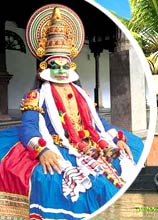 Mohiniattam
dance is a very expressive form of dance of Kerala. It is made of two
words, "mohini" and "attam". Mohini refers to a
beautiful lady and attam means dance. So this traditional Mohiniattam
dance form basically means the dance of an enchantress. In Kerala,
classical mohiniatam dance form evolved centuries back under the
influence of the great king of Travancore, Swati Tirunal. This king was
a great patronage of fine arts and encouraged artists from all over
India to perform in his court.
Mohiniattam
dance is a very expressive form of dance of Kerala. It is made of two
words, "mohini" and "attam". Mohini refers to a
beautiful lady and attam means dance. So this traditional Mohiniattam
dance form basically means the dance of an enchantress. In Kerala,
classical mohiniatam dance form evolved centuries back under the
influence of the great king of Travancore, Swati Tirunal. This king was
a great patronage of fine arts and encouraged artists from all over
India to perform in his court.The make up and costume of a dancer is very simple yet beautiful. Emphasis is laid on eye make up since most expressions involve emoting through eyes. The color of the costume is usually white or off-white with a golden or a red border. The hair is done up in a bun on the side just above the ear and is decorated with flowers. The jewellery is usually an elaborate pair of earrings and a choker for neck, teamed with a long necklace of coins. Legend has it that Lord Vishnu assumed the form of a gorgeous heavenly enchantress called Mohini to derive the "Pot of Amrit" (potion for immortality), which was in possession of the Demons. He seduced the demons in the form of the divine seductress and somehow managed to get hold of the pot. The dance that was performed to mesmerize the demons is now called "Mohiniattam".
The music is usually classical carnatic, typical of south Indian variations and style of music. It is sung by trained singers or the teacher who teaches the performers to dance. This beautiful style of dance involves the use of eye movements that are sensual yet does not provoke the viewer but enchants in such a way that it is not overt. The idea is to charm without being offensive. The fluttering eye lashes, the curved eye brows and the captivating eyes all enchant the viewers and take them to a virtual paradise!








